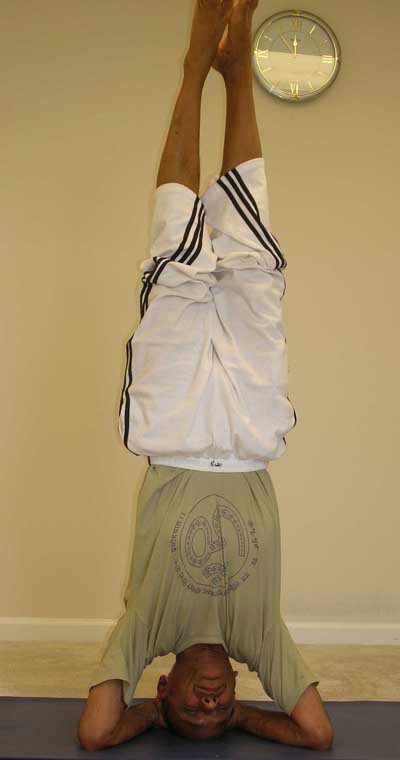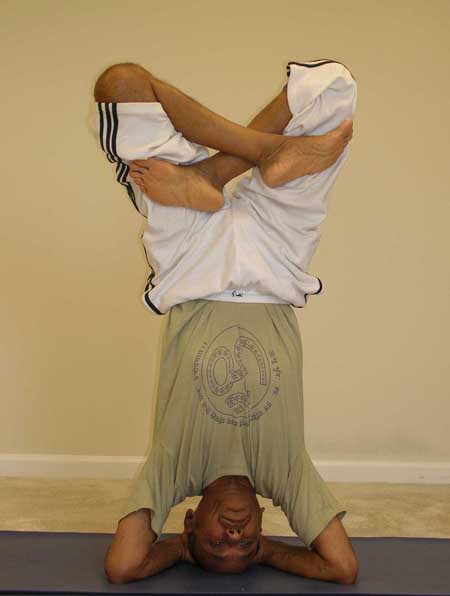In a previous article, we talked about one of the commonly practiced inverted poses called Sarvangasana (shoulder stand). In today’s article, I am going to discuss another very important inverted pose – Shirshasana – (शीर्षासन) –
Preparation for the asana
- It is highly advisable that the shirshasana be learned under the guidance of an experienced teacher.
- Beginners should use a wall for support in the early stages. This will help them develop the necessary strength in the neck, shoulders and the head as well as help them develop self-confidence so they can eventually practice it without any support.
- This asana should be gradually learned in stages, not trying to do too much, too soon!
- Always use a cushion – a blanket or a yoga mat -to practice upon so that the head feels comfortable on the floor in the final position.
Step-by-step
- Place the mat against the wall. Start by sitting in the Vajrasana (diamond pose). Bending forward, place the forearms on the floor with the fingers interlocked. The distance between the elbows should be approximately the length of a forearm. If you are planning to use the wall for support, keep the hands about 8-10 inches away from the wall.
- Place the crown of the head against the palms with the forehead lightly resting on the floor.
- Lift the knees and buttocks off the floor and straighten the legs. Now, start walking your feet toward your forehead and try to bring the hips directly above the shoulders.
- Begin to lift your feet and using the core strength, raise the legs up keeping the knees bent. When the knees reach a vertical position, raise the feet up as well so that the whole body is in a fully vertical position. This is the final shirshasana position.
- If you are a beginner, you may like to rest your feet against the wall. Avoid resting the buttocks against the wall. After a few days of practice, you may experiment by lifting the feet off the wall. Once you feel confident of balancing your body in the final position, you may attempt to practice this asana away from the wall.
- You can maintain the final position for as long as comfortable. With practice, you may be able to stay in the position for upto five minutes.
- To come out of the pose, we use a technique which is just the reverse of what we used to get into the pose. Start by bending the knees, bringing the heels against the buttocks.
- Start lowering the knees toward your chest and then slowly lower the feet to the floor. When the knees and the feet are on the floor, then roll the buttocks back to rest in the child pose (balasana) for about 8-10 breaths.
Optional Variations
When you become comfortable maintaining the final position without the support of the wall, you may like to introduce a few variations while you are in shirshasana.
Variation 1
- While you are in shirshasana, spread the legs wide apart. Stay there for about 5-7 breaths.
- Begin to twist the body around in one direction so the legs create a scissor-like movement. Keep the knees as straight as possible.
- Stay in the twisted position for a few breaths and then return back to the center. Then repeat the above move in the other direction. Finally coming back to the center and slowly bringing the feet together again.
- When you are ready to come out of the pose, repeat steps 7 and 8 mentioned above.
Variation 2
- In this variation, you try to bring the legs into the lotus position (padmasana). Start lowering one foot and bring it on top of the opposite thigh. Then lower the other foot and cross it over the other thigh in the full lotus position.
- You can stay in this position for as long as you are comfortable. To come out, raise one leg at a time and get back to the vertical position.
- When you are ready to come out of the pose, repeat steps 7 and 8 mentioned above.
Contraindications
- Shirshasana should not be practiced by people who suffer from high blood pressure, migraine, heart disease, catarrh, chronic constipation, kidney problems, weak eye blood vessels or any other eye condition, spinal injury.
- Women who are pregnantor or are in their menstuation cycle should not practice shirshasana.
- If you have a medical condition that you are not sure of, consult your physician or the yoga teacher before practicing shirshasana.
Benefits
Shirshana provides the following benefits:
- Direct enriched oxygenated blood to the brain cells, rejuvenating them and making them more efficient.
- Prevent migraine and headache as it helps strengthen the blood vessels that cause headaches due to compression.
- Strengthen the glandular system and activate the pituitary glands.
- Work on the thyroid glands thus improving the metabolic function
- Increased blood circulation can help alleviate two common ailments, hemorrhoids and varicose veins, which are cuased by insufficient blood circulation in the legs and the anus area
- Recommended for the prevention of asthma, allergies, diabetes and menopausal imbalances.




I am 59 years and practice asanas . Amongst the asanas I practice are sarvangasa, akranpidasana, shirsana,pashimotasna , chakrasana, matsya asana. Ardhamatsyendra asana ,/halasana with kapalbhati . I am not an expert practioner butI have been doing this asanas daily. should I continue for these asanas in old age also?
As long as your body doesn’t complain, you should continue your practice while you are still “young”. That way you will stay young and not have to worry about doing the practice in “old age”.
Thank you , Subhash. Need one metre help. I have stopped all forward bending exercises with the onset of osteoarthritis Sometimes back. The pain is not of any significant severity.but I do get up with a stiff back. Apart from ,the other asanas, I have been practising markat asanas with a good bit of relief . Can you suggest any forward bending asanas. I can do balasana , Shashank asana but have stopped them
Hello Ramesh, indeed, Markatasana is one of the highly recommended poses for relief from back stiffness. In fact, you can practice all the twisting stretches, seated or standing as long as you keep them gentle. Even the forward bending poses like the ones you have mentioned – balasana, shashakasana etc., if done at a gentle level can be beneficial for the back. You may want to visit this page on my blog where I have given a few more stretches for the back – http://yogawithsubhash.com/2016/07/25/yoga-for-a-healthy-pain-free-lower-back/
blood presure controlled by medication can I do headstand
Yes, as long as the BP is controlled, it is OK to do the headstand. You may still need to monitor your BP from time to time just to make sure.
I am 70 years and practice asanas . Amongst the asanas I practice are sarvangasa, shirsana, matsya asana. Ardhamatsyendra asana halasana . I also do Kapaal Bhakti, analog vilom, and surya bhedi pranayama. I am by no means an expert practioner although I have been doing asanas for quite sometime. What frequency should I maintain for these asanas
Hello Ramesh, good to see that you are a regular practitioner of yoga. If you are comfortable with your practice, continue to do them on a daily basis. Age is not an important factor. What is more important is how you feel during and after the practice.
what are timings we need to do,can i do at 12 am before lunch
Yes, Laxma, it is OK to practice yoga at 12 noon as long as you give yourselves a 3-hour gap between the previous big meal and yoga.
What do you think sir … cleansing practices are necessary before going in regular practice of shirshasana. Shat karmas arr imp before headstand nasophyrengeal region , chest and abdomen cleansing.
Hello Dame,
I don’t believe that it is necessary to do the cleansing practices before shirshasana. They will definitely help but not mandated to practice shirshasana.
What all kind of eye problem people should not practice shirshasana? Let me know if someone is wearing contact lenses should practice headstand? What all eye conditions?
Hi Dame,
Yes, you should be able to practice shirshasana if you are wearing contact lenses. I don’t have a good answer to your question about avoiding shirshasana with specific eye conditions. Hopefully someone else reading the blog may help. In general, though, it is recommended that you should avoid shirshasana if it causes any kind of strain to the eyes.
my friend , i threw away glasses after practising shirshana for 3 months. hope you can do it too.
Hi Ankit,
Glad to see that the practice of Shirshasana helped you with your eyesight. Keep the practice going!
I enjoy the shirshasana position very much. I feel comfortable inspite of my 65 years of age and inspite the 150/90 blood presure. Should I nvertheless abstein from it?
As per my understanding, if you have blood pressure which is uncontrolled despite medication, then Shirshasana is not recommended for you. On the other hand, I read in a recent medical report that for people above the age of 60, 150/90 can be considered the higher limit of the accepted range. I guess, depending upon the fluctuations that you see in your BP, you may decide yourself if the pose is desirable for you or not.
Hi, i have hyperopia…. i want to improve my eye sight -5… i’ve started doing shirshasana … will this pose help me to get rid of my
crutches forever?????
Hello Vanessa,
There are no guarantees when you practice yoga. What i can say is that the practice of yoga will make your mind stronger which will help you deal with any physical condition effectively.
Dear Shreyas, I am not aware of any ill effects that shirshasana can have due to shortsightedness. You may want to consult with your medical doctor just to confirm. Best of luck with your yoga practice.
Hi Sir
I have short sightedness with -1.25 power on both the eyes and I wear spectacles, can you please confirm can I start with this Asana.
GOOD